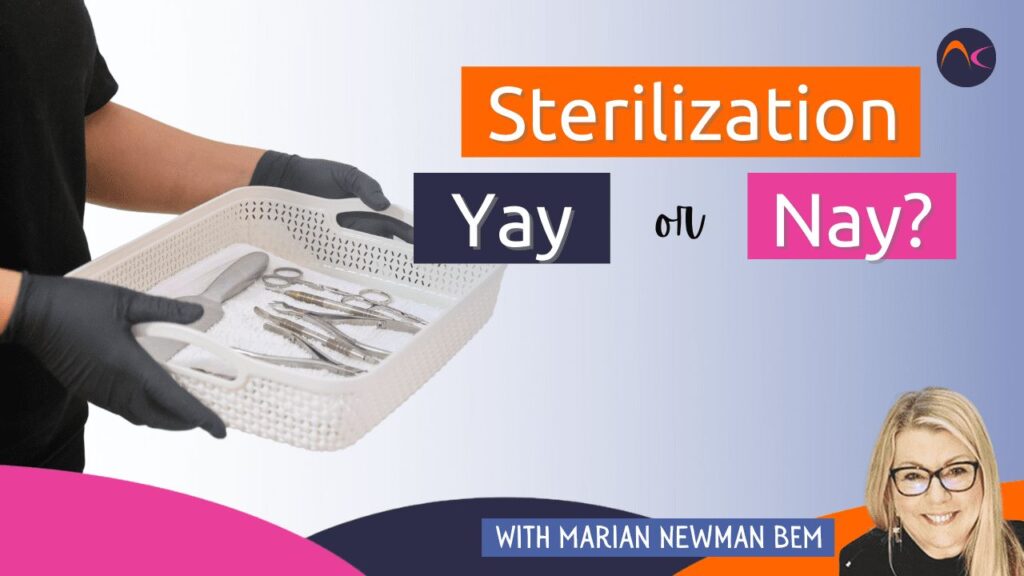For the last two years, there have been endless discussions on Health & Safety measures and hygiene due to the pandemic. But, for decades, every country has had training courses that are clearly ‘not fit for purpose’. They do not teach their students about the decontamination levels that will guarantee to keep their clients (and themselves and employees) as safe as possible. We are talking about cleaning/sanitizing, disinfection, and sterilization.
Even with some lack of education, the pandemic should have brought some focus onto hygiene and understanding what is required for us, nail professionals. From some ‘digging’, it seems that there are several levels within the sector:
- los que se toman muy en serio la higiene y la descontaminación, y comprenden los niveles
- los que tienen una comprensión razonable, y hacen todo lo posible
- aquellos a los que les gusta que sus clientes piensen que sus niveles de higiene son altos, pero posiblemente no entienden del todo
- los que no se centran en la higiene real.
¿Cuál es usted?
The debate on whether nail services need an autoclave continues with plenty of arguments on both sides. In reality, an autoclave is essential for tools that may come into contact with any bodily fluids. This would suggest that nail services do not require this level of hygiene. But do they?
It is very easy to nick the skin with a file or cuticle nippers. It is also easy to cause a minor abrasion on the skin with a buffer, and it is definitely easy to cause an abrasion when using an e-file at the base of the nail and on the Proximal Nail Fold.
A cut on the skin is usually obvious as it will bleed. If it is a file that has caused the wound, we can discard it. If it is a metal tool, then it will likely have blood on it however minuscule. However, with a minor abrasion, the likelihood is that it will not be noticed immediately. But as soon as it happens it will become slightly wet. This is plasma from the blood that is clear and may have some white blood cells in it; it could be lymphatic fluid. Both are there to help protect the wound from infection. (Red blood cells and other blood bourn cells will arrive to heal the wound, and this is when the redness/inflammation can be seen some time after). As the PNF is living skin there can also be leakage of the contents of the skin cells.
Así pues, esta descripción muestra cómo las herramientas pueden estar en contacto con fluidos corporales sin que te des cuenta. Ahí está el argumento a favor de un autoclave, sobre todo si se utiliza una lima electrónica sobre la piel.
También existe el argumento de que una profesional de las uñas prefiere tomar todas las precauciones posibles en materia de salud y seguridad, y quiere que sus clientas sean conscientes de que lo hace, para que se sientan seguras.
The autoclave is the highest level of decontamination but one level down from that is using a hospital-grade disinfection system. This is very specific and it should say in the brand specifications and marketing what level of pathogens it will destroy. It will have clear instructions on how to use it, and it will be strong enough to be harmful to the skin. For nail services with no autoclave, this level is non-negotiable. It must be part of any hygiene routine for metal tools. If the instructions are followed to the letter, it will be good enough for any minor contact with bodily fluids.
Un simple desinfectante no hará este trabajo eficazmente.
Bajando un nivel se encuentra un desinfectante para superficies duras. Sigue sin ser adecuado para el contacto con la piel, pero puede utilizarse para limpiar escritorios, suelos, interruptores de la luz, pomos de puertas, etc. No limpia adecuadamente las herramientas metálicas.
The lowest level is ‘cleaning’ and this falls into two categories:
- El método preferible es un jabón líquido, agua corriente (caliente o fría) y suficiente tiempo en contacto con el jabón y el agua.
- Limpiador a base de alcohol, a menudo en forma de gel. Se presenta en forma de gel porque el alcohol debe permanecer en contacto con la superficie durante un breve periodo de tiempo, y un gel se evapora más lentamente que un líquido fino.
Este nivel es esencial para la limpieza de las manos tanto del profesional de uñas como de todos los clientes. El primer método siempre debe ser el primero y, a continuación, el segundo debe servir de apoyo en el mostrador. El segundo método nunca debe sustituir al agua y el jabón en los servicios de uñas.
El primer método, con agua y jabón, es también un paso ESENCIAL antes de que los dos niveles superiores (autoclave y desinfectante de grado hospitalario) puedan llevarse a cabo de forma eficaz. Cada herramienta debe lavarse con agua y jabón líquido utilizando un cepillo para eliminar todos los residuos y aceites que dificultarán el proceso de descontaminación.
Your safety, your client’s safety, and the safety of others around you are paramount. Do not cut corners. It is far better and far more professional to go over and above where hygiene is concerned.
Más información en Higiene adecuada en el salón de manicura.


